2019 年 6 月英语六级真题第二套
Part I Writing (30 minutes)
Directions: For this part, you are allowed 30 minutes to write an essay on the
importance of mutual understanding and respect in interpersonal relationships. You
should write at least 150 words but no more than 200 words.
PartⅡ Listening Comprehension (30 minutes)
Section A
Directions: In this section, you will hear two long conversations. At the end of
each conversation, you will hear four questions. Both the conversation and the
questions will be spoken only once. After you hear a question, you must choose the
best answer from the four choices marked A),B),C) and D). Then mark the corresponding
letter on Answer Sheet 1 with a single line through the centre.
Questions 1 to 4 are based on the conversation you have just heard.
1. A) A six- month-long negotiation.
B) Preparations for the party.
C) A project with a troublesome client.
D) Gift wrapping for the colleagues.
2. A) Take wedding photos.
B) Advertise her company.
C) Start a small business.
D) Throw a celebration party.
3. A) Hesitant.
B) Nervous.
C) Flattered.
D) Surprised.
�
4. A) Start her own bakery.
B) Improve her baking skill.
C) Share her cooking experience.
D) Prepare for the wedding.
Questions 5 to 8 are based on the recording you have just heard.
5. A) They have to spend more time studying.
B) They have to participate in club activities.
C) They have to be more responsible for what they do.
D) They have to choose a specific academic discipline.
6. A) Get ready for a career.
B) Make a lot of friends.
C) Set a long-term goal.
D) Behave like adults.
7. A) Those who share her academic interests.
B) Those who respect her student commitments.
C) Those who can help her when she is in need.
D) Those who go to the same clubs as she does.
8. A) Those helpful for tapping their potential.
B)Those conducive to improving their social skills.
C)Those helpful for cultivating individual interests.
D)Those conducive to their academic studies.
Section B
�
Directions:In this section, you will hear two passages. At the end of each passage,
you will hear three or four questions. Both the passage and the questions will be
spoken only once. After you hear a question, you must choose the best answer from
the four choices marked A),B),C) and D). Then mark the corresponding letter on
Answer Sheet 1 with a single line through the centre.
Questions 9 to 11 are based on the passage you have just heard.
9.A) They break away from traditional ways of thinking.
B) They are prepared to work harder than anyone else.
C) They are good at refining old formulas.
D) They bring their potential into full play.
10. A) They contributed to the popularity of skiing worldwide.
B) They resulted in a brandnew style of skiing techniques.
C) They promoted the scientific use of skiing poles.
D) They made explosive news in the sports world.
11. A) He was recognized as a genius in the world of sports.
B)He competed in all major skiing events in the world.
C)He won three gold medals in one Winter Olympics.
D)He broke three world skiing records in three years.
Questions 12 to 15 are based on the passage you have just heard.
12. A) They appear restless.
B) They lose consciousness.
C) They become upset.
D) They die almost instantly.
13. A) It has an instant effect on your body chemistry.
�
B)It keeps returning to you every now and then.
C)It leaves you with a long lasting impression.
D)It contributes to the shaping of you mind.
14. A) To succeed while feeling irritated.
B) To feel happy without good health.
C) To be free from frustration and failure.
D) To enjoy good health while in dark moods.
15. A) They are closely connected.
B) They function in a similar way.
C) They are too complex to understand.
D) They reinforce each other constantly.
Section C
Directions: In this section, you will hear three recordings of lectures or talks
followed by three or four questions. The recordings will be played only once. After
you hear a question, you must choose the best answer from the four choices marked
A), B), C) and D). Then mark the corresponding letter on Answer Sheet 1 with a single
line through the centre.
Questions 16 to 18 are based on the recording you have just heard.
16. A) They differ in their appreciation of music.
B) They focus their attention on different things.
C) They finger the piano keys in different ways.
D) They choose different pieces of music to play.
17. A) They manage to cooperate well with their teammates.
B) They use effective tactics to defeat their competitors.
�
C) They try hard to meet the spectators’ expectations.
D) They attach great importance to high performance.
18. A) It marks a breakthrough in behavioral science.
B) It adopts a conventional approach to research.
C) It supports a piece of conventional wisdom.
D) It gives rise to controversy among experts.
Questions 19 to 21 are based on the recording you have just heard.
19. A) People’s envy of slim models.
B) People’s craze for good health.
C) The increasing range of fancy products.
D) The great variety of slimming products.
20. A) They appear vigorous.
B) They appear strange.
C)They look charming.
D) They look unhealthy.
21.A) Culture and upbringing.
B) Wealth and social status.
C)Peer pressure.
D) Media influence.
Questions 22 to 25 are based on the recording you have just heard.
22. A) The relation between hair and skin.
B) The growing interest in skin studies.
�
C)The color of human skin.
D) The need of skin protection.
23. A) The necessity to save energy.
B) Adaptation to the hot environment.
C)The need to breathe with ease.
D)Dramatic climate changes on earth.
24. A) Leaves and grass.
B) Man-made shelter.
C)Their skin coloring.
D) Hair on their skin.
25.A) Their genetic makeup began to change.
B)Their communities began to grow steadily.
C)Their children began to mix with each other.
D)Their pace of evolution began to quicken.
Part Ⅲ Reading Comprehension (40 minutes)
Section A
Directions: In this section, there is a passage with ten blanks. You are required
to select one word for each blank from a list of choices given in a word bank following
the passage. Read the passage through carefully before making your choices. Each
choice in the bank is identified by a letter. Please mark the corresponding letter
for each item on Answer Sheet 2 with a single line through the centre. You may not
use any of the words in the bank more than once.
Questions 26 to 35 are based on the following passage.
The dream of personalised flight is still vivid in the minds of many inventors, some
developing cycle-powered craft, others 26 money into jetpacks (喷气飞行背包).
However, the flying car has always remained the 27 symbol of personal transport
�
freedom.
Several companies around the world have produced 28 that can drive on roads and fly.
Airbus has a futuristic modular (组件式的) concept involving a passenger capsule
that can be
29 from the road-going chassis (底盘) and picked up by a helicopter-type machine.
But all these concepts are massively expensive, require safety certification
standards for road and air, need 30 controls, involve complex folding wings and
propellers, and have to be flown from air-strips. So they are likely to remain rich
people’s playthings rather than practical transport solutions for the masses.
“A car that takes off from some London street and lands in another 31 street is
unlikely to happen,” says Prof. Gray, a leading aeronautical engineer. “Sky taxis
are much more likely.” But that won’t stop inventors from dreaming up new ways
to fly and trying to persuade investors to back their sometimes 32 schemes.
Civilian aviation is being disrupted, not by the age-old desires for speed,
romanticism and
33 , but by the pressing need to respond to a changing climate. New electric engines
coupled with artificial intelligence and 34 systems will contribute to a more
efficient, integrated transport system that is less polluting and less noisy. That
may sound simple, but as Prof. Gray says, “When I travel somewhere I like this notion
that when I finish my journey I feel better than when I started it. That’s completely
at 35 with how I feel today.” Now that would be progress.
A) autonomous
B) detached
C) dual
D) glamour
E) imminent
F) odds
G) opposites
H) outrageous
Section B
I) pouring
j) prototypes
K) random
L) repressing
M) segmented
N) spectrum
O) ultimate
Directions: In this section, you are going to read a passage with ten statements
attached to it. Each statement contains information given in one of the paragraphs.
Identify the paragraph from which the information is derived. You may choose a
paragraph more than once. Each paragraph is marked with a letter. Answer the
questions by marking the corresponding letter on Answer Sheet 2.
�
Companies Are Working with Consumers to Reduce Waste
A) As consumers, we are very wasteful. Annually, the world generates 1.3 billion
tons of solid waste. This is expected to go up to 2.2 billion by 2025. The developed
countries are responsible for 44% of waste, and in the U.S. alone, the average person
throws away their body weight in rubbish every month.
B) Conventional wisdom would seem to suggest that companies have no incentive to
lengthen the life cycle of their products and reduce the revenue they would get from
selling new goods. Yet, more and more businesses are thinking about how to reduce
consumer waste. This is partly driven by the rising price of raw materials and metals.
It is also partly due to both consumers and companies becoming more aware of the
need to protect our environment.
C) When choosing what products to buy and which brands to buy from, more and more
consumers are looking into sustainability. This is opposed to just price and
performance they were concerned about in the past. In a survey of 54 of the world’
s leading brands, almost all of them reported that consumers are showing increasing
care about sustainable lifestyles. At the same time, surveys on consumers in the
U.S. and the U.K. show that they also care about minimizing energy use and reducing
waste.
D) For the most part, consumers control what happens to a product. But some companies
are realizing that placing the burden of recycling entirely on the consumer is not
an effective strategy, especially when tossing something away seems like the easiest
and most convenient option.
E) Some retailers and manufacturers in the clothing, footwear, and electronics
industries have launched environmental programs. They want to make their customers
interested in preserving their products and preventing things that still have value
from going to the garbage dump. By offering services to help expand the longevity
of their products, they’re promising quality and durability to consumers, and
receiving the reputational gains for being environmentally friendly.
F) For example, the Swedish jeans company Nudie Jeans offers free repair at twenty
of their shops. Instead of discarding their old worn-out jeans, customers bring them
in to be renewed. The company even provides mail-order repair kits and online videos,
so that customers can learn how to fix a pair of jeans at home. Their philosophy
is that extending the life of a pair of jeans is not only great for the environment,
but allows the consumer to get more value out of their product. When customers do
want to toss their pair, they can give them back to the store, which will repurpose
and resell them. Another clothing company, Patagonia, a high-end outdoor clothing
store, follows the same principle. It has partnered with DIY website iFixit to teach
consumers how to repair their clothing, such as waterproof outerwear, at home. The
�
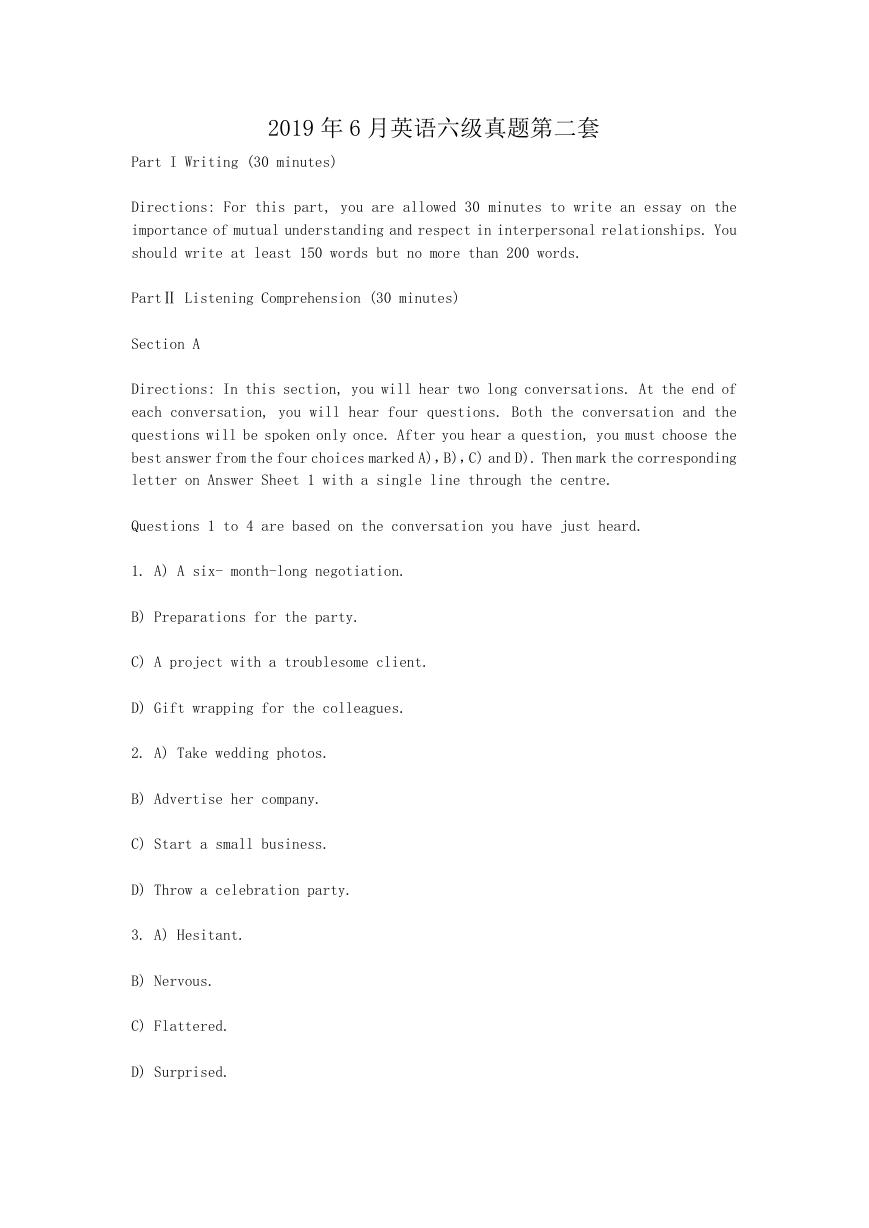
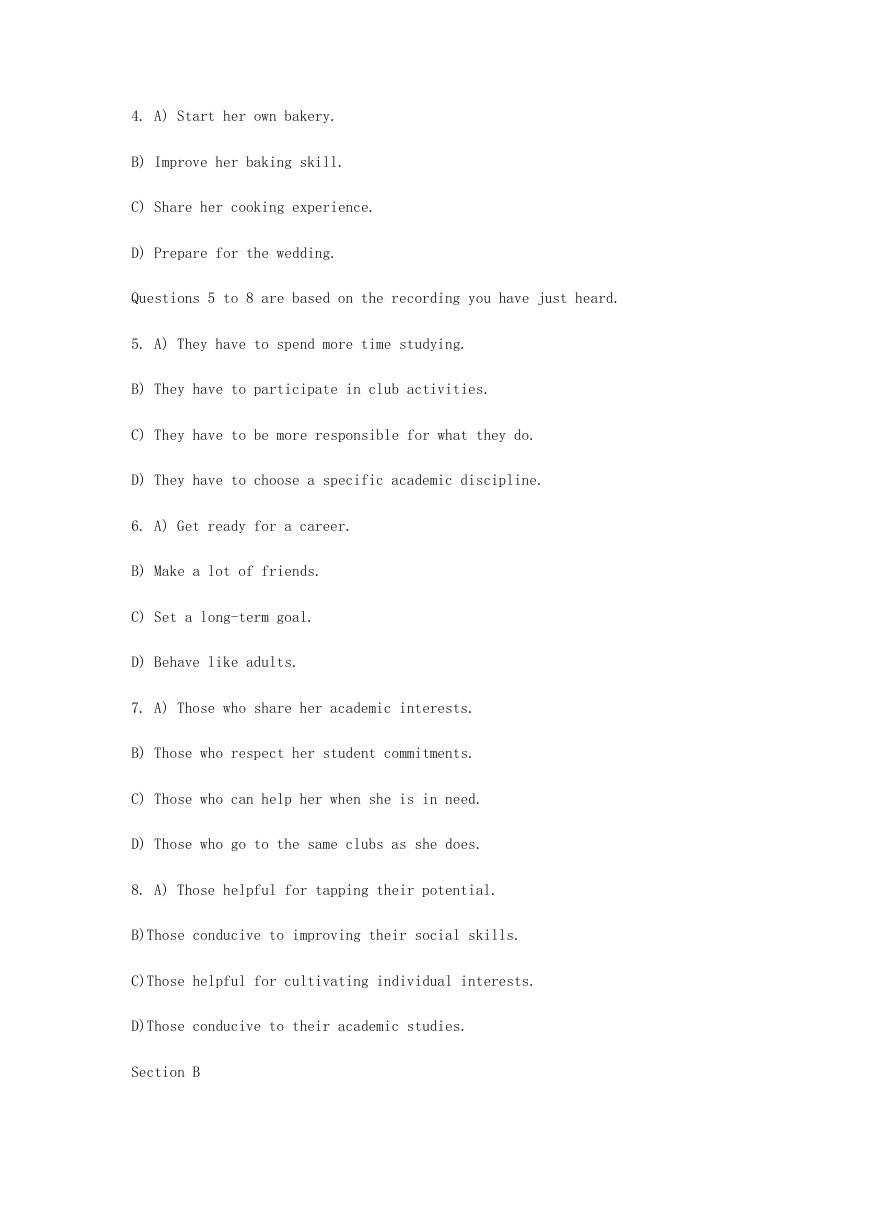
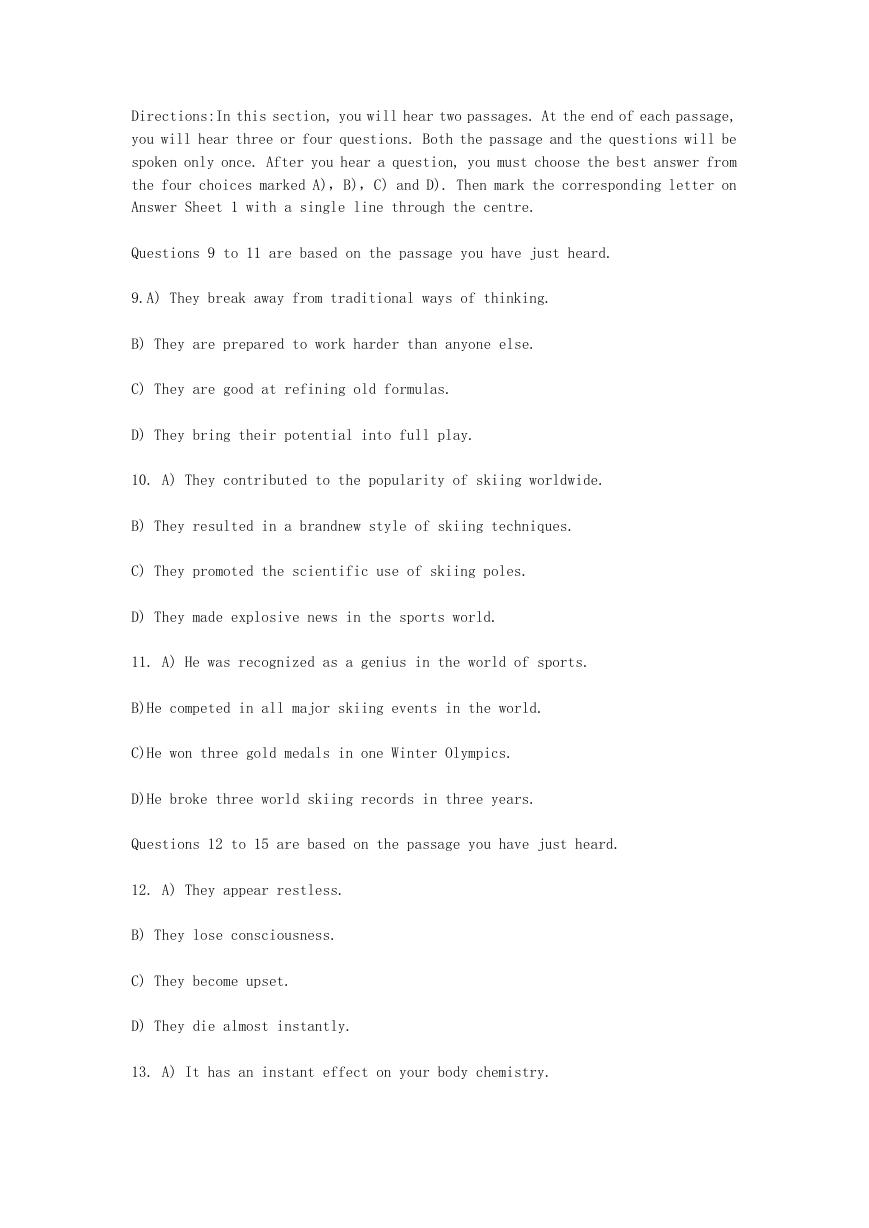
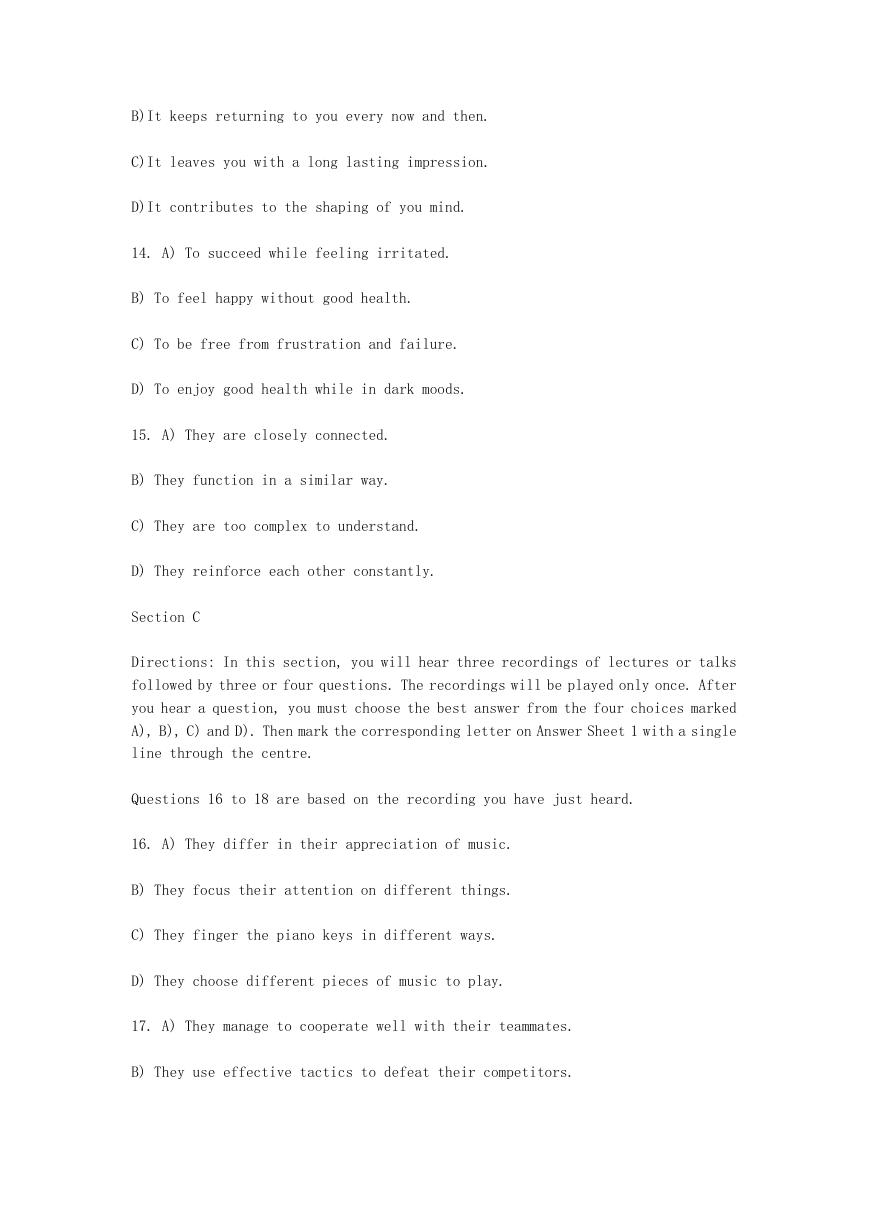
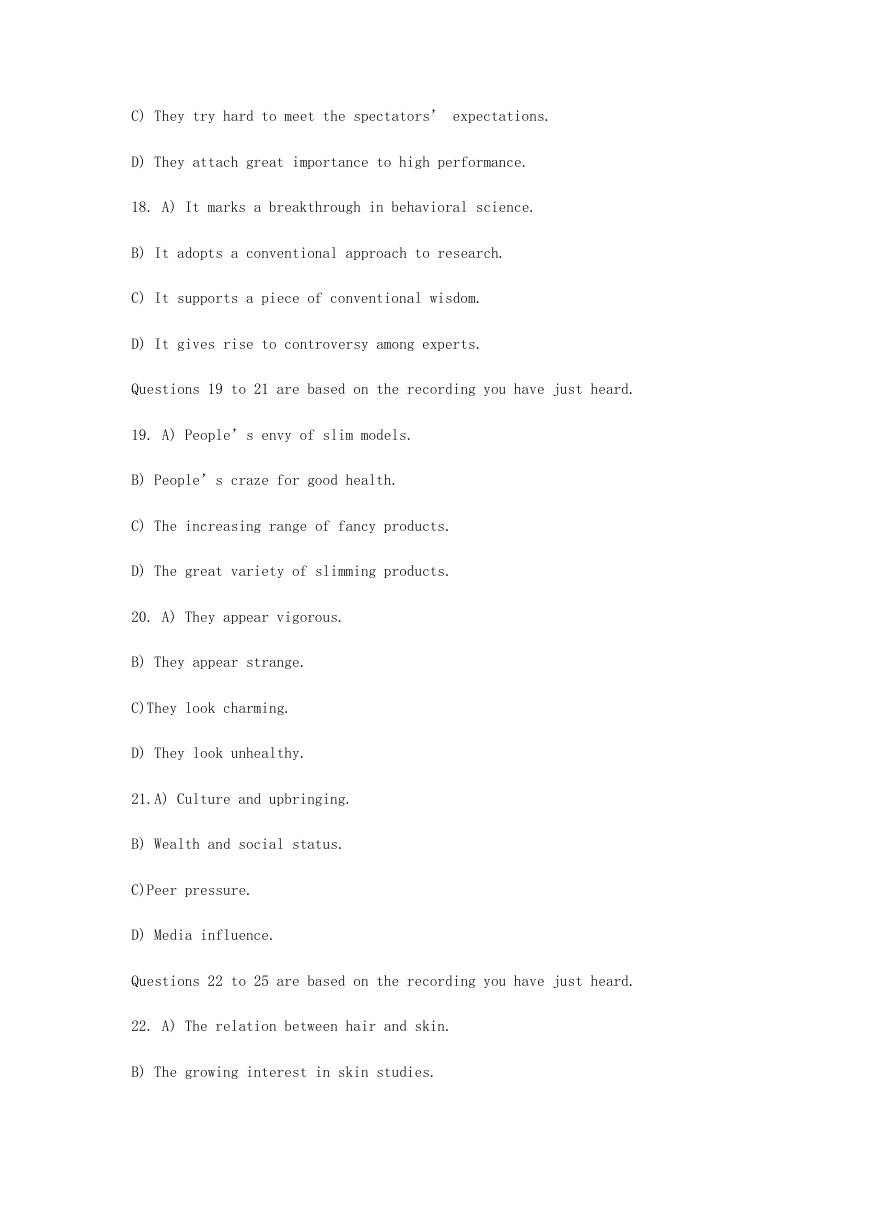


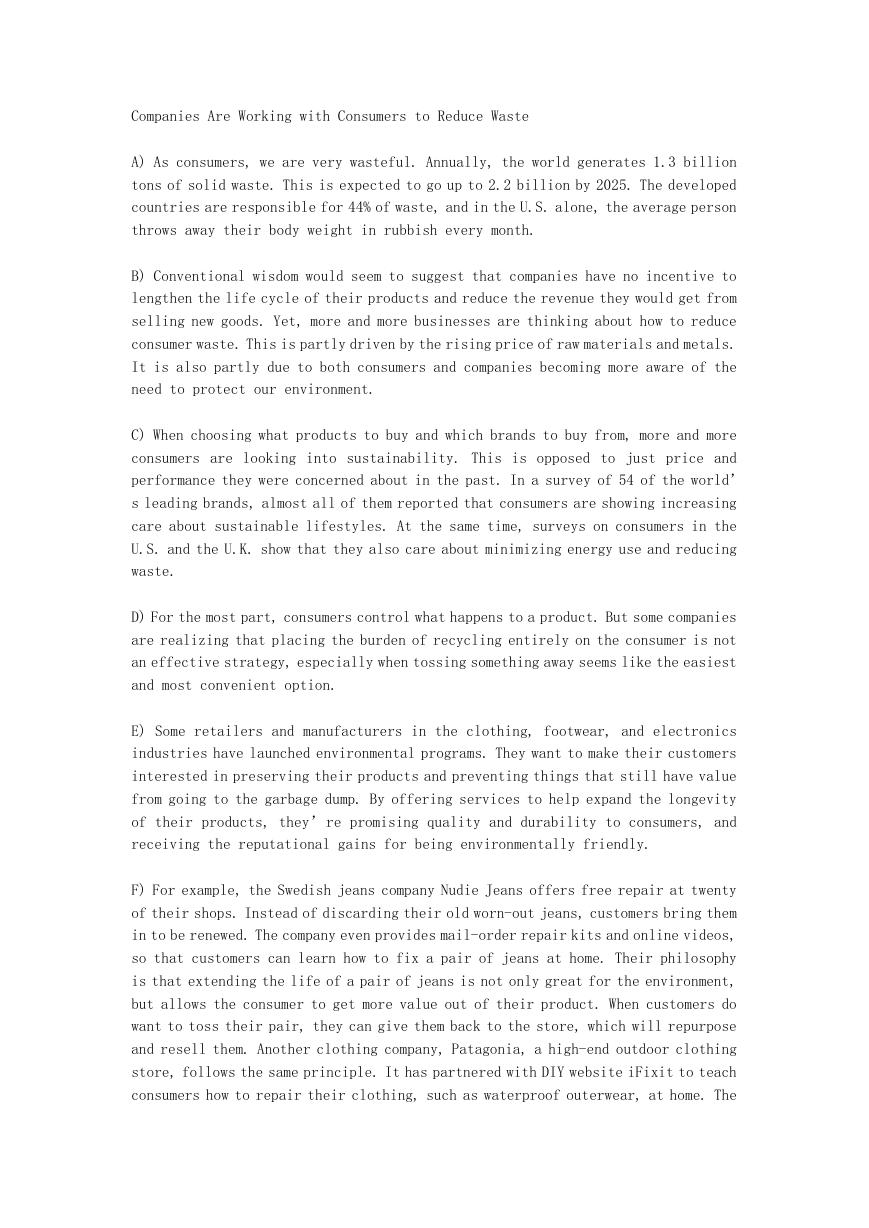








 2023年江西萍乡中考道德与法治真题及答案.doc
2023年江西萍乡中考道德与法治真题及答案.doc 2012年重庆南川中考生物真题及答案.doc
2012年重庆南川中考生物真题及答案.doc 2013年江西师范大学地理学综合及文艺理论基础考研真题.doc
2013年江西师范大学地理学综合及文艺理论基础考研真题.doc 2020年四川甘孜小升初语文真题及答案I卷.doc
2020年四川甘孜小升初语文真题及答案I卷.doc 2020年注册岩土工程师专业基础考试真题及答案.doc
2020年注册岩土工程师专业基础考试真题及答案.doc 2023-2024学年福建省厦门市九年级上学期数学月考试题及答案.doc
2023-2024学年福建省厦门市九年级上学期数学月考试题及答案.doc 2021-2022学年辽宁省沈阳市大东区九年级上学期语文期末试题及答案.doc
2021-2022学年辽宁省沈阳市大东区九年级上学期语文期末试题及答案.doc 2022-2023学年北京东城区初三第一学期物理期末试卷及答案.doc
2022-2023学年北京东城区初三第一学期物理期末试卷及答案.doc 2018上半年江西教师资格初中地理学科知识与教学能力真题及答案.doc
2018上半年江西教师资格初中地理学科知识与教学能力真题及答案.doc 2012年河北国家公务员申论考试真题及答案-省级.doc
2012年河北国家公务员申论考试真题及答案-省级.doc 2020-2021学年江苏省扬州市江都区邵樊片九年级上学期数学第一次质量检测试题及答案.doc
2020-2021学年江苏省扬州市江都区邵樊片九年级上学期数学第一次质量检测试题及答案.doc 2022下半年黑龙江教师资格证中学综合素质真题及答案.doc
2022下半年黑龙江教师资格证中学综合素质真题及答案.doc